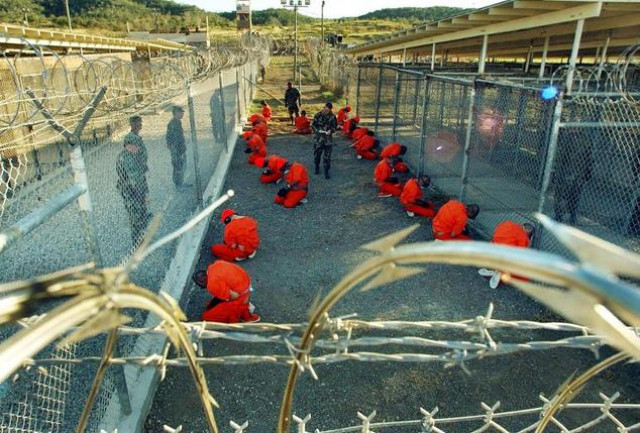
The controversial report, condemned by a few Republican officials and lauded by others, brings some much needed transparency to CIA’s conduct, which, as it turned out, was much worse than we previously knew. Here's what you need to know:
1. Torture was much worse than we thought
Everyone knows that the CIA tortured under the Bush administration. We’ve all seen Zero Dark Thirty, and even President Obama admitted as much when we said “we tortured some folks”. But what the Senate Report uncovers is that the agency employed many techniques that previously were not known, which include ‘walling’ detainees, a term that means slamming detainees’ heads and bodies against a wall repeatedly. Worse, the detainees were often nude and sleep deprived during these sessions. Other techniques that the CIA had employed were ‘rectal hydration’ and ‘rectal feeding’, which entailed food and water being infused through the rectum of the detainees. The CIA also conducted mock executions, and threatened to kill and rape the detainees’ family members. As for the techniques that we already knew, like water boarding and sleep deprivation, the report shows how they were employed on a far larger scale than the CIA had previously admitted.

SOURCE: INTELLIGENCE.SENATE.GOV

This photo reviewed by the US military and made during an escorted visit shows a US naval medic explaining the "feeding chair" procedures at the detention facility in Guantanamo Bay, Cuba, on April 9, 2014. PHOTO: AFP
2. A lot of it was not necessary
A large chunk of the report is devoted to the handling of Khalid Sheikh Mohammad, the chief suspect of the 9/11 attacks and Daniel Pearl’s murder. When he was first brought to ‘Detention Site Cobalt’ a prison in Afghanistan, he was spoken to for only ‘a few minutes’ before interrogators started torturing him.
In another instance, the CIA tortured another suspect, despite the organization noting that ‘he was cooperative’
This is telling, because the default position the CIA has always held is that ‘enhanced interrogation’ was only employed sparingly, and only when detainees had refused to divulge information. This, the Senate Report proves, was a lie.

SOURCE: INTELLIGENCE.SENATE.GOV
3. Real information gathered simply by asking questions was dismissed
“KSM's [Khalid Sheikh Mohammad] reporting during his first day in CIA custody included an accurate description of a Pakistani/British operative, which was dismissed as having been provided during the initial "'throwaway' stage" of information collection when the CIA believed detainees provided false or worthless information”

Khalid Sheikh Mohammad. PHOTO: AFP
According to this excerpt it seems that when reliable information was provided, it was dismissed. This happened on multiple occasions, with many prisoners, who, despite divulging credible information, were tortured any way. In the instance below, the report shows that torture was used punitively, not as an instrument.

SOURCE: INTELLIGENCE.SENATE.GOV
4. It complicated US’s foreign relations, including Pakistan
The report has largely redacted the names of the countries where the secret facilities were held, save for Thailand, Afghanistan, Poland, and Romania. As investigators dig in, more countries like Egypt and Morocco are also said to have cooperated with the CIA. Although Pakistan is not directly implicated, the report does highlight high levels of cooperation between Pakistan and the CIA in first detaining suspects, such as Khalid Sheikh Mohammad, Abu Zubaydah, and Ridha al-Najjar, who were all captured in Pakistan. The report reveals that in many instances, the CIA lied to host countries about what went on in the facilities. In other instances, it paid millions of dollars to host countries to keep those detention centres operational (the CIA told host government when asking for compensation to ‘think big’). Pakistan’s claims of being lied to are credible, especially during the Raymond Davis affair, and the consequences of the many of the tactics the CIA employed when dealing with other countries – lack of trust, private contractors, detention facilities – all seem to have affected Pakistan’s relations with the United States adversely.

SOURCE: INTELLIGENCE.SENATE.GOV
5. It didn’t work
The core takeaway of the report seems to be that the ‘enhanced interrogation techniques’ the CIA employed simply were not effective in gathering meaningful information. Here’s an excerpt from the report’s executive summary:
“according to CIA records, seven of the 39 CIA detainees known to have been subjected to the CIA's enhanced interrogation techniques produced no intelligence while in CIA custody.* CIA detainees who were subjected to the CIA's enhanced interrogation techniques were usually subjected to the techniques immediately after being rendered to CIA custody. Other detainees provided significant accurate intelligence prior to, or without having been subjected to these techniques.”
In the case of Khalid Sheikh Mohammad, after a few days of torture, he actually provided false information that led to the capture of detention of two innocent people.

SOURCE: INTELLIGENCE.SENATE.GOV
6. It was mostly done by private contractors, and it was expensive
A name many Pakistanis would be familiar with is Blackwater, and the Senate report reveals that by 2005, almost 85% of the ‘enhanced interrogation’ programs was outsourced to private contractors. The two psychologists codenamed ‘Dunbar’ and ‘Swigert’(who had no combat or interrogation experience) who designed the program were collectively paid $180 million for their ‘work’. The CIA spent many millions more building and maintaining these detention facilities, making it a booming business for private military corporations.

SOURCE: INTELLIGENCE.SENATE.GOV

Activists demonstrate water boarding in front of the Justice Department in Washington DC in 2007. PHOTO: AFP
7. Some terror plots were monumentally stupid
While focusing primarily on the CIA’s role in the covert side of the war on terror, the report also intimates some of the many schemes, plots and plans that many militants were working with, and some of them were downright bizarre. Having a read a satirical article on how to make a nuclear bomb, suspect Jose Padilla evidently thought he could make a nuclear centrifuge by placing a chunk of uranium “"in a bucket, attaching it to a six-foot rope, and swinging it around your head as fast as possible for 45 minutes. Padilla and Mohammed approached Abu Zubaydah in early.

SOURCE: INTELLIGENCE.SENATE.GOV


















COMMENTS
Comments are moderated and generally will be posted if they are on-topic and not abusive.
For more information, please see our Comments FAQ